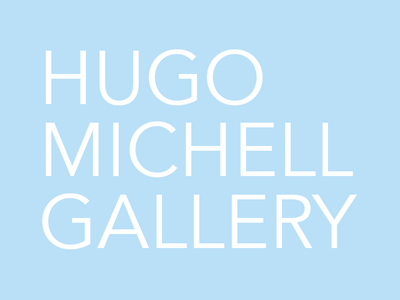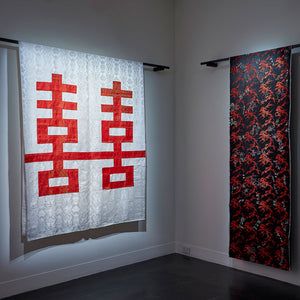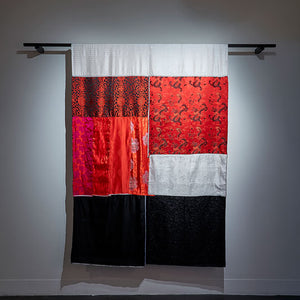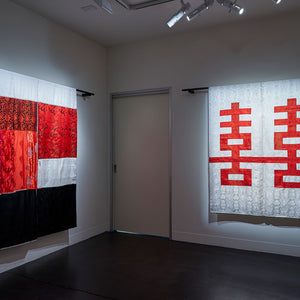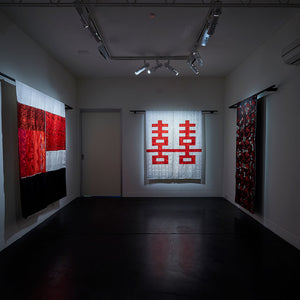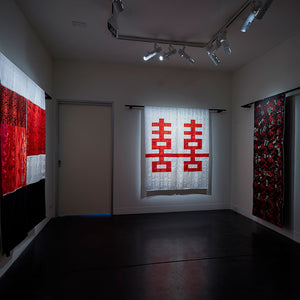'What does love have to do with it?' by Sophia Cai
One of the truisms that we are told about love is that absence makes the heart grow fonder, that distance from our dear ones makes us love them even more. Perhaps this is part of the motivations behind Kate Just’s exhibition From China with Love, a series of textile-based works and a photograph created during the artist’s residency in Beijing in 2018 that are part love letter and part dissenting commentary. Exploring topics of love, commitment, relationships, and gender, Just’s small but considered exhibition implores us to consider the common bonds that make up human relationships. The stories behind the works are informed by cultural history and personal experience, but also traverse those bounds and interpretations.
Just is a fearless artist, who over the course of her career has created courageous works driven by conviction and an underlying belief in the power of art as a tool to address social themes and topics. While she has predominantly engaged with knitting and other highly crafted methods to create her works, she resists the label of ‘craftivism’. If craftivism implies resistance through the act of ‘gentle persuasion’, and elevating relics of the everyday to the sphere of the political, Just’s works do not temper to this softness but instead have a tenacious approach with no complacency or moderation. The political is embedded in Just’s practice from conception to realisation – the medium-specificity of her works do not lessen their impact.
The three textile works in From China with Love are made from fabrics sourced by the artist during her time in Beijing. Exhibited together as wall hangings, the works speak to one another while also reflecting China’s cultural history and rich textile traditions. Two of the works, In the Mood for Love and Double Happiness (Queer Love) explore ideas of companionship and power dynamics in personal relationships. With In the Mood for Love, Just makes visual reference to the idea of a couple through a composition divided in two down the middle. Like two sides of a shared bed, this work suggests the way that two separate people with similarities and differences come together as one in a couple.
In Double Happiness (Queer Love), Just appropriates a traditional Chinese symbol associated with marriage, the 囍 or ‘Double Happiness’ character, to represent a more inclusive version of love. The character is a ligature, comprised of two individual characters喜meaning ‘joy’ that visually come together to form a duo or partnership. For Just, what the Double Happiness symbol promises beyond its visual harmony is a marriage between equals and also a marriage of any possible gender combination.
This idea of an equal partnership is significant to consider in respect to marriage equality and human rights. While love is an arguably private experience, its public display or expression is still controlled and mediated by exterior forces. As the recent marriage equality debate in Australia demonstrated, the ‘rules of love’ are shaped by government policy and societal biases. We cannot take for granted that love is a universal right, or that love is something that can be experienced freely by all, when there remains inequality due to discrimination. For Just to make a work like Double Happiness (Queer Love) in the context of China, where there are currently no laws to protect LGBTQI+ from discrimination and no options for same-sex marriage, is a telling critique.
A key part of Just’s artistic practice is an engagement with broader communities through socially inclusive interventions. The fabric scroll Me Too我也是Rice Bunny米兔 was made in response to the Me Too movement and in recognition of the individual stories of women in China. The title is an allusion to the hashtag #MeToo, which was censored on social media in China. In its place, netizens and feminists of China used the words米兔(rice bunny), which phonetically sounds like ‘mi tu,’ to address sexual harassment and discrimination. The fabric piece is embroidered by more than sixty women Just met and invited to participate, with their individual narratives literally being stitched together to tell a bigger story. The resulting work is a powerful testament to feminist solidarity.
What is notable about this exhibition is that despite the focus on human relationships and connections, the body is noticeably invisible. While we can trace the hands of the embroiderers in Me Too我也是Rice Bunny米兔and understand the implied coupling in In the Mood for Love and Double Happiness, there is no conspicuous person or personhood being represented. This ‘absence’ of a body is perhaps most notably felt in the work Single Happiness/Beijing Wedding, which also stands apart in the exhibition as the single photograph work.
In the photograph we see a traditional Chinese wedding suite, lushly decorated with red draping fabrics and celebratory decorations. Just took this photograph while she stayed in the suite overnight to perform a private wedding to herself. We do not see what this ceremony looked like, but are rather invited to reflect on the space and what this marriage represents. By erasing the trace of herself from the scene, Just also invites us to imagine ourselves in this situation. If marriage is a commitment for life, through the good times and the bad, how can we extend that love to ourselves?
This comes back to the crux of From China with Love, which is a body of work that explores the intimacies and bonds we form with others, but also the significance of maintaining one’s individuality. Just’s practice empowers us to look closely and critically at the intimate relationships we build in our lives, and consider the complex ways in which we love, sustain, and support one another.
Sophia Cai is a Melbourne-based curator and arts writer. She is interested in Asian art history, the intersection between contemporary art and craft, as well as feminist methodologies and community-based practices. Cai completed her Masters in History of Art at the Courtauld Institute of Art in London in 2014, specialising in contemporary Chinese art.
